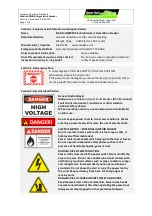
GMC-I Messtechnik GmbH
61
6.4 Description
All setting, query, register management and interface commands
are listed alphabetically in the following pages (*A..., *B..., *C...,
..., A..., B..., C..., ...). In addition to the application-specific
overview in the previous chapter, setting, query and status
commands are included in the appendix arranged according to
function.
*CLS – Clear Status
Settings
Functions
Clears all event registers:
ESR, ERA and ERB.
Clears the status byte register (except for the MAV bit).
Any service requests SRQ are cleared.
Manual operation is not possible.
Programming
Setting command:
*CLS
Example (HP Basic):
OUTPUT 713; “*CLS”
Action
Addressing status
Unchanged
Input and output buffers
Unchanged
Service request
SRQ
Cleared
Status byte register
STB
Cleared except for MAV bit
Event registers
ESR, ERA, ERB
Cleared
Enable registers
ESE, ERAE, ERBE, SRE, PRE
Unchanged
Set or stored parameters
Unchanged
*DDT, *DDT? – Define Device Trigger
Functions
A command list with
up to 80 characters
can be saved to a
register
with the help of the
DDT
command.
The command list is executed after receiving the
*TRG
command.
Programming
Setting command: *
DDT
command [/command][/command]
...
Parameter:
Command
Parameter type:
All specified device commands and
queries except for the *TRG command
Setting range:
Max. 80 characters
Default setting:
DDT
memory cleared (after RESET, *RST)
Example
(HP Basic):
OUTPUT 713; "*DDT USET 10 / ISET 5.6
/ TSET 05.00 / OUT ON"
OUTPUT 713; "USET 2"
:
OUTPUT 713;"*TRG"
Comments
The slash in the command defines the command only, without
executing it immediately.
An
empty DDT register
returns a blank as a response.
The command list is not checked for correct syntax and limit
values until a trigger command is received.
*TRG
may
not
be included in the
*DDT
command. Otherwise, bit
4 (EXE, execution error) would be set in the standard event
register, and bit 3 (DDTE, define device trigger error) would be
set in event register B.
If the maximum string length is exceeded, all characters in
excess of the allowable number are ignored and an execution
error message is generated as well.
In the case of “EXE”, the DDT register can be read out with
DDT?, but its content cannot be executed (“EXE” error
message).
Query
Read out content of the
DDT
register.
Programming
Query command: *
DDT?
Response string:
*DDT
command [;command][;command]
...
Length:
Max. 80 characters
Parameter:
Command
Example
(HP Basic):
OUTPUT 713; "*
DDT?
"
ENTER 713; A$
DISP A$
Display:
USET 10;ISET 5.6;TSET 0.5.00; OUT ON
*IDN? – Device Identification Query
Functions
The KONSTANTER identifies itself.
Manufacturer, type designation, serial number, hardware
revision and software (firmware) revision.
Programming
Query command:
*IDN?
Response string:
manufacturer,type,serial no.,hardware
revision.software revision
Length: 46
characters,
fixed
Example
for KONSTANTER 120 W / 40 V:
GOSSEN-METRAWATT,SSP32N040RU006P,
XXXXXXXXX,04.001
*IST? – Individual Status Query
Functions
Command for directly querying parallel poll information
(see also chapter 6.3 on page 60 and table: “Query
Commands for Status and Events Management” on page 86).
Current status of the device’s IEEE488.1 “IST” message.
Content is not changed by the query.
An ASCII coded byte is returned as a response.
When using the RS232 interface
without
the IEEE488 interface
value 1 is generally returned as a response.
Programming
Query command:
*IST?
Response string:
0 : “Local message is false”
1 : “Local message is true”
Length:
1 character, fixed
Example (HP Basic):
OUTPUT 713; “*IST”
ENTER 713;A$
DISP A$
Display:
0
Summary of Contents for SSP 120 Series
Page 2: ...2 GMC I Messtechnik GmbH ...
















































